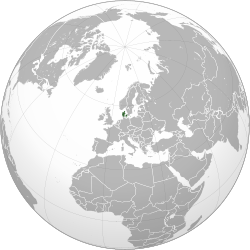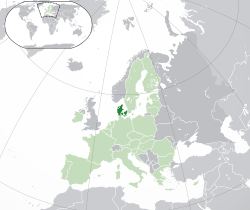Denmark Danmark (Danish) | |
|---|---|
| Anthem: Der er et yndigt land (Danish) (English: "There is a lovely country") | |
| National and royal anthem: Kong Christian stod ved højen mast (Danish)[N 1] (English: "King Christian stood by the lofty mast") | |
Location of metropolitan Denmark (dark green) – in Europe (light green & dark grey) | |
| Sovereign state | Kingdom of Denmark |
| Consolidation | c. 8th century[2] |
| Constitutional Act | 5 June 1849 |
| Capital and largest city | Copenhagen 55°43′N 12°34′E / 55.717°N 12.567°E |
| Official languages | Danish |
| German[N 2] | |
| Ethnic groups (2020) | |
| Demonym(s) | |
| Government | Unitary parliamentary constitutional monarchy |
• Monarch | Frederik X |
| Mette Frederiksen | |
| Legislature | Folketing |
| Area | |
• Total | 43,094[5] km2 (16,639 sq mi) (130th) |
• Water (%) | 1.74[6] |
| Highest elevation (Møllehøj) | 170.86 m (560.56 ft) |
| Population | |
• September 2024 estimate | |
• Density | 138.8/km2 (359.5/sq mi) (93rd) |
| GDP (PPP) | 2024 estimate |
• Total | |
• Per capita | |
| GDP (nominal) | 2024 estimate |
• Total | |
• Per capita | |
| Gini (2022) | low |
| HDI (2022) | very high · 5th |
| Currency | Danish krone[N 5] |
| Time zone | UTC+01:00 (CET) |
• Summer (DST) | UTC+02:00 (CEST) |
| Calling code | +45 |
| Internet TLD | .dk[N 6] |
| Website | denmark |
Denmark (Danish: Danmark, pronounced [ˈtænmɑk] ) is a Nordic country in the south-central portion of Northern Europe with a population of nearly 6 million;[7] 770,000 live in Copenhagen (1.9 million in the capital region).[7] It is the metropolitan part, and most populous constituent part of, the Kingdom of Denmark,[N 7] a constitutionally unitary state that includes the autonomous territories of the Faroe Islands and Greenland in the North Atlantic Ocean.[11] Metropolitan Denmark[N 8] is the southernmost of the Scandinavian countries, lying south-west and south of Sweden, south of Norway,[N 9] and north of Germany, with which it shares a short border.
As of 2013, the Kingdom of Denmark, including the Faroe Islands and Greenland, had a total of 1,419 islands greater than 100 square metres (1,100 sq ft) in area; 443 have been named and 78 are inhabited.[12] Spanning a total area of 42,943 km2 (16,580 sq mi),[13] metropolitan Denmark consists of the northern part of the Jutland peninsula and an archipelago of 406 islands.[14] Zealand is Denmark's most populated island, followed by Funen, then the North Jutlandic Island and Amager.[15] Copenhagen, Denmark's capital and most populous city, is located on Zealand and Amager. Denmark has flat, arable land, sandy coasts, low elevations, and a temperate climate. Denmark exercises hegemonic influence in the Danish Realm, devolving powers to handle internal affairs. Home rule was established in the Faroe Islands in 1948. Greenland obtained home rule in 1979 and further autonomy in 2009.[16]
The unified Kingdom of Denmark emerged in the 8th century AD as a maritime power amid the struggle for control of the Baltic Sea.[2] In 1397, it formed the Kalmar Union with Norway and Sweden. This union persisted until Sweden's secession in 1523. The remaining Kingdom of Denmark–Norway endured a series of wars in the 17th century that resulted in further territorial cessions. A surge of nationalist movements in the 19th century were defeated in the First Schleswig War of 1848. The adoption of the Constitution of Denmark on 5 June 1849 ended the absolute monarchy and introduced the current parliamentary system. An industrialised exporter of agricultural produce in the second half of the 19th century, Denmark introduced social and labour-market reforms in the early 20th century, forming the basis for the present welfare state model and advanced mixed economy. Denmark remained neutral during World War I; Danish neutrality was violated in World War II by a rapid German invasion in April 1940. During occupation, a resistance movement emerged in 1943, while Iceland declared independence in 1944; Denmark was liberated after the end of the war in May 1945. In 1973, Denmark, together with Greenland but not the Faroe Islands, became a member of what is now the European Union, but negotiated certain opt-outs, such as retaining its own currency, the krone.
Denmark is a developed country with a high standard of living, and was the first country to legally recognise same-sex partnerships. It is a founding member of NATO, the Nordic Council, the OECD, the OSCE and the United Nations, and is part of the Schengen Area. Denmark maintains close political, cultural, and linguistic ties with its Scandinavian neighbours. The Danish political system is used in political science as a reference point for near-perfect governance and the term "getting to Denmark" is used to describe how other countries can improve their governments.[17][18]
- ^ "Not one but two national anthems". Ministry of Foreign Affairs of Denmark. Archived from the original on 15 May 2014. Retrieved 18 May 2014.
- ^ a b Stone et al. (2008), p. 31.
- ^ "Bekendtgørelse af ILO-konvention nr. 169 af 28. juni 1989 vedrørende oprindelige folk og stammefolk i selvstændige stater". Retsinformation.dk. 9 October 1997. Archived from the original on 8 October 2020. Retrieved 30 September 2020.
- ^ "Den dansk-tyske mindretalsordning". UM.dk. Archived from the original on 29 September 2020. Retrieved 30 September 2020.
- ^ "Denmark". Central Intelligence Agency. 21 November 2023. Archived from the original on 5 July 2021. Retrieved 22 November 2023.
- ^ "Surface water and surface water change". Organisation for Economic Co-operation and Development (OECD). Archived from the original on 24 March 2021. Retrieved 11 October 2020.
- ^ a b c "Development in the number of inhabitants month by month". www.dst.dk. Statistics Denmark. Retrieved 27 October 2024.
- ^ a b c d "World Economic Outlook Database, October 2024 Edition. (Denmark)". www.imf.org. International Monetary Fund. 22 October 2024. Retrieved 27 October 2024.
- ^ "Gini coefficient of equivalised disposable income – EU-SILC survey". ec.europa.eu. Eurostat. Archived from the original on 9 October 2020. Retrieved 25 November 2023.
- ^ "Human Development Report 2023/24" (PDF). United Nations Development Programme. 13 March 2024. p. 288. Archived (PDF) from the original on 13 March 2024. Retrieved 13 March 2024.
- ^ *Benedikter, Thomas (19 June 2006). "The working autonomies in Europe". Society for Threatened Peoples. Archived from the original on 9 March 2008. Retrieved 8 June 2012.
Denmark has established very specific territorial autonomies with its two island territories
- Ackrén, Maria (November 2017). "Greenland". Autonomy Arrangements in the World. Archived from the original on 30 August 2019. Retrieved 30 August 2019.
Faroese and Greenlandic are seen as official regional languages in the self-governing territories belonging to Denmark.
- "Greenland". International Cooperation and Development. European Commission. 3 June 2013. Archived from the original on 16 September 2014. Retrieved 27 August 2019.
Greenland [...] is an autonomous territory within the Kingdom of Denmark
- Ackrén, Maria (November 2017). "Greenland". Autonomy Arrangements in the World. Archived from the original on 30 August 2019. Retrieved 30 August 2019.
- ^ "About Denmark". Archived from the original on 27 December 2022. Retrieved 27 December 2022.
- ^ "Area". Statistics Denmark. Archived from the original on 14 April 2019.
- ^ "Denmark in numbers 2010" (PDF). Statistics Denmark. Archived (PDF) from the original on 18 April 2013. Retrieved 2 May 2013.
- ^ "Statistikbanken". statistikbanken.dk. Archived from the original on 6 June 2023. Retrieved 27 December 2022.
- ^ "Greenland and the Faroe Islands". Ministry of Foreign Affairs Denmark. Archived from the original on 18 December 2023. Retrieved 18 December 2023.
- ^ "Getting to Denmark". The New Republic.
- ^ O'Sullivan, Mike. "Has Europe Turned The Corner On Immigration?". Forbes.
Cite error: There are <ref group=N> tags on this page, but the references will not show without a {{reflist|group=N}} template (see the help page).



